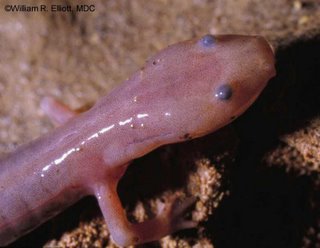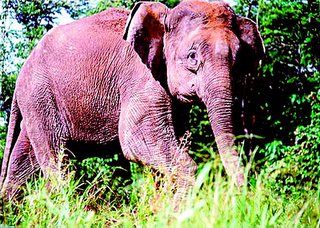I could watch these all day. You read it right - a ballistic tongue. Some salamanders actually fire their own tongues at prey...and weird looking tongues they are. I found this site years ago and it still fascinates me.
Stephan Deban is a Biology professor at the University of South Florida. His website has a fantastic collection of slow-motion video of salamanders feeding. Ok, that may sound boring...salamander opens mouth and shoves in worm. I assure you, you will be amazed-especially by Hydromantes supramontis - a cave dweller from Sardinia. It launches its tongue 80% of its body length.
LINK
Saturday, December 31, 2005
Friday, December 30, 2005
Bat Poop-eating Salamander

For some reason this story appeals to me on several levels not the least being my British heritage and their love of scatalogical humor. I would like to subtitle this entry as Eating Bat Poop better than a Big Mac.
The grotto salamander is a cave dweller, as are a number of salamander species around the world. It is an interesting beast that is blind as an adult. As a larval salamander it has functional eyes and often develops outside of caves. The adults live exclusively in caves. Other blind salamanders retain their gills as adults and never leave the water. It was previously thought that Grotto salamanders ate insects and cave shrimp that fed on bat guano. A recent study of a population of salamanders in Oklahoma revealed an unusual feeding habit. It turns out that since so much of the bat guano is undigested insects the bat crap is more nutritious that the shrimp! I love this stuff. The best part of the study was comparing the protein and fat contents of the bat guano, the shrimp, and a MacDonald's big mac. The bat guano came out on top with 54% protein and 1% fat while the Big Mac was 23% protein and 33% fat. The Shrimp was in the middle with 44% protein and 8% fat.
Link
Panda Bonanza

A few weeks ago I was in Washington DC for the American Association of Tropical Medicine and Hygience Meeting. I gave two talks on the blood parasite Babesia microti, a pathogen that our research group at the American Red Cross studies.
While in Washington, my family and I visited the National Zoo and of course we had to see the pandas, especially the new baby panda. I'm glad to report that the baby is doing well and recently took a romp outside with its mother.
Pandas have an advantage when it comes to conservation...they're cute. I mean really cute. My children like a website devoted to all things cute called cuteoverload.com. When visiting the site I saw a picture from the Wolong Panda Reserve in China. This year they had 18 babies born, a record. Here is a picture of 16 of them being held by their keepers from the China Daily Website.
Condor Progress
 The San Diego Zoo reports that California Condors reintroduced to the Baja Peninsula of Mexico have begun to expand their range northward and may be seen flying in San Diego County for the first time since 1910. There are 4 groups of birds in the US and Mexico, all reintroductions descended from 14 birds. Eventually it is hoped that the southern California population and the Mexico population will meet up.
The San Diego Zoo reports that California Condors reintroduced to the Baja Peninsula of Mexico have begun to expand their range northward and may be seen flying in San Diego County for the first time since 1910. There are 4 groups of birds in the US and Mexico, all reintroductions descended from 14 birds. Eventually it is hoped that the southern California population and the Mexico population will meet up.In 1985, while I was in High School, I took a weekend trip to California to try and see one of the last wild birds (I think they were down to 6). I flew a redeye People's Express from Hartford to Los Angeles for $99 round trip. I think my only food that weekend was a large package of hot cross buns I bought for a dollar. I did have to drop over 100 bucks to stay at Marina del Rey so I could take one of the fishing boats out. At a lookout in Los Padres National Forest I saw one of these magnificent birds, so large they look like a small plane. Within a few years all the birds were captured for the captive breeding program. Today there are about 270 birds, over 100 free flying.
LINK
photo from San Diego Zoo Website
Wednesday, December 28, 2005
Birding in the Buff

A story from the Japan Times by a naturalist with a penchant for wildlife watching while soaking in hot springs. A new one for listers - the bath list.
"An hour later, feeling part boiled and part frozen, I exited the pool having recorded an astonishing 21 species, ranging from those Whooper swans, goldeneye and goosander, to white-backed, great spotted and Japanese pygmy woodpeckers." - Mark Brazil
Monday, December 26, 2005
Thylacine (Tasmanian Tiger) website

A site devoted to the possibly extinct Thylacine, an amazing predatory marsupial from the island of Tasmania. The author (C. Campbell) visited the Australian museum to study the specimens there and observe the extraction of Thylacine DNA. There is enough preserved material that chances are good that a complete genome will eventually be sequenced. Recent evidence has surfaced that a small number may still be alive. If one was documented it would be a story of greater magnitude than the Ivory-billed woodpecker.
LINK
The Pygmy Elephants of Borneo

For years there have been arguments about the small population of Asian Elephants living on the island of Borneo. These elephants were smaller than their mainland cousins and considerably more docile. Some people thought these elephants were feral animals that had come from a once domestic population. The closest other Asian elephants are on the Island of Sumatra in Indonesia. When I was in Borneo I didn't have the chance to see these creatures because their range is so limited, found only in the extreme northeast corner of the island.
Recent DNA studies have shown that this population is a distinct subspecies that has been separated from other living populations for up to 300,000 years. When the sea level was lower Borneo was part of the Asian mainland. This is evidenced in the fact that the fauna of Borneo is predominantly Asian. Across a narrow, but deep strait of water is the island of Sulawesi. Sulawesi was never part of the mainland and has a mixture of a few Asian animals like monkeys, two wild pigs and some small wild cows (Anoa) plus a contingent of birds and mammals with origins in the Australasian area.
As the sea level rose the Bornean elephants became isolated.
The World Wildlife Fund is tracking some of these elephants by GPS hoping to better understand their movements and behavior. They are working with the government of the Indonesian state of Sabah to help preserve this distinct population of elephants. It is thought that the population stands at between 500 to 2000 animals.
There are only 35,000 wild asian elephants thought to be still roaming around in 10 countries in South and Southeast Asia.
Sunday, December 25, 2005
New Trout species found in Russia
A new species of fish in the same genus as our brook trout has been discovered in far eastern Russia. Technically the fish is a char, a group somewhere between the trout and salmon taxonomically.
http://www.practicalfishkeeping.co.uk/pfk/pages/item.php?news=782
http://www.practicalfishkeeping.co.uk/pfk/pages/item.php?news=782
Change of scope
I'm expanding the topics covered on this blog to anything about the natural world that I consider interesting, which is a lot. I envision this as a natural history boingboing.net or something. Here goes...
Subscribe to:
Posts (Atom)